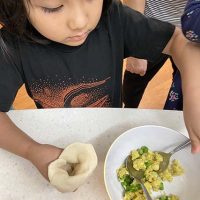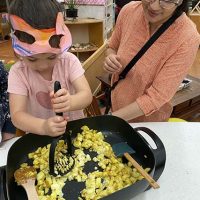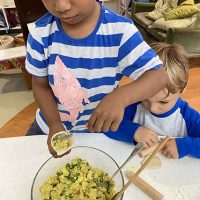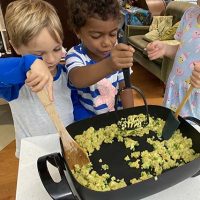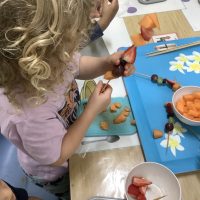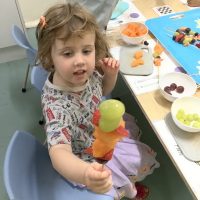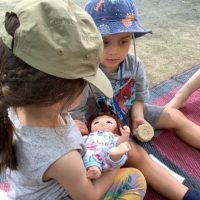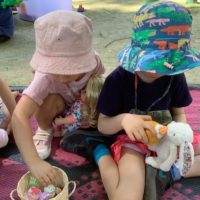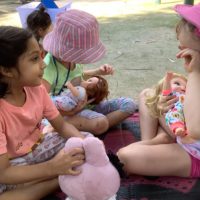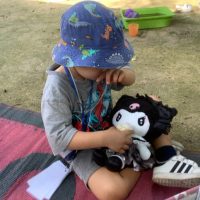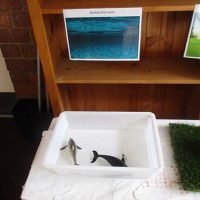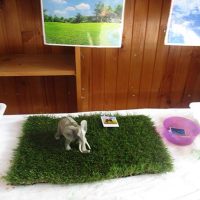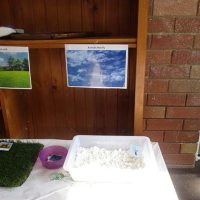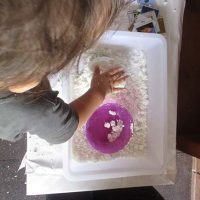Gorton House
Preschool
Story by Educator Nicky
The children in Gorton House preschool continue to enjoy regular and varied cooking experiences and the children influence many of the recipes and foods explored.
One child recently came to the preschool room and told us that she had recently eaten a samosa at home and found that she loved it so much! We asked her about the samosa—what it tasted like, what it looked like and what was inside it, and the child answered every question with such eagerness, relaying that it was spicy, but only a little bit spicy, and that it had potato inside it and “those little green things, the round ones” which we reasoned were peas! (This surprised us as this child usually doesn’t like peas). We named some of the spices the samosa might have contained, perhaps curry? We sought the insight of educator Gunjan, who regularly makes samosas at home.
Gunjan told us the samosas likely contained ground cumin, turmeric, coriander and ginger. Then the child stated, “We can make them here!”. So of course, plans and lists were made, and ingredients sought. We loved that this child, was oh so excited to discover she now actually loves peas, whereas before she avoided them, and was telling everyone that peas were now one of her favourite vegetables.
On the day the samosas were made we gathered to explore the ingredients. Gunjan had helped the children prepare the samosa dough the previous day, so on the day, we made the filling, chopping potatoes and peas and adding a collection of the spices recommended by Gunjan. We tasted the ingredients individually, and also whilst cooking. The aromas of the spices and the vegetables floating through the air were so tempting. We looked at images of samosas so we would have visual prompts.
The children were involved in every part of the process, including wrapping their own samosas. Gunjan demonstrated how to roll and cut the dough before making a cone shape and filling it with the prepared mixture. The children always reinforce what we know in these situations, that they are incredibly capable when trusted. When given the tools, space and time they made their own little samosas, to their hearts content, eating them straight out of our air fryer, toasty hot! Some of the children loved them so much that they made several, and we saw not a single child reject a single pea! One child, whose family makes their own samosas at home all the time, never eats them herself, but she said she’d make one for her family. She took it home and gave it to her parents to share, and she was so proud to have made it for them.
The child who instigated the experience made at least six samosas, meaning she was a little too full for lunch. The smile on hers and the faces of all the children involved told us that these samosas are now a favourite recipe, and we are looking forward to making them a regular menu item. The children are already talking about what we might put in the next batch, with tofu being a listed ingredient. Our children love tofu, and getting tofu in the preschool room for many children is like being given gold!
Johnson House
Preschool
Story by Educator Sanju
This week in Johnson House preschool, a small group of children were invited to make some fruit kebabs. Everyone had their own chopping boards, and we shared the knives around to cut the fruit into small pieces. Each fruit was different in texture and taste.
As the children started to feed the skewer into the fruits, they realised the difference in difficulty in doing this, as some of the fruits were soft, making it easy to push the skewer through, while others were hard, therefore needing more force.
Then, using the metaphor of the different fruits, we talked about how different we all are from one another in terms of looks, behaviour, family and our beliefs. It was fun to hear, for example, that some children have pets or siblings while others have extended families.
Through this experience, the children learned about the different fruits’ names, colours and textures. We discussed how they were all different, but delicious, and how they had lots of vitamins in them which help us grow healthy and strong. In this hands-on experience the children learned some basic food preparation skills such as washing, cutting and so on, and how to be careful with the pointy ends of the skewers. The children were also practicing their fine motor skills, hand-eye coordination and mental concentration, all of which are precursors to writing.
To foster early numeracy, I asked children how many pieces of a specific fruit they chose, providing them with the opportunity to practice basic counting skills.
The children also observed how their friends were making different patterns with their fruit skewers and, as any choice was correct and there was no ‘right’ or ‘wrong’ way to do this, it helped them build their self-confidence. They also learned about our similarities and differences as we talked about how each individual fruit was different and delicious in its own special way and then linked this back to our own individualities.
Robinson House
Story by Educator Denise
Continuing Robinson House’s children’s interest in my combined literacy and social play experiences, I invited the children to read and interact through a dialogic reading of ‘The Invisible Boy’, by Trudy Ludwig. Dialogic reading involves an adult and children having a dialogue around the text they are reading. Through this dialogic reading, the children had opportunities to build their social connections with me and each other, their understanding of the world around them, their concentration and learning dispositions and their literacy and verbal language skills.
‘The Invisible Boy’ tells the story of a young boy named Brian who feels invisible in his classroom. This was symbolised by him being drawn in black and white while the other characters are drawn with colours. We noted his sad and lonely emotions when his classmates didn’t acknowledge his presence during lunch and when it came to playing games. However, this changes when he begins to make friends with another boy named Justin. Justin was initially made fun of due to him eating food differently from his classmates. Brian empathises with Justin’s situation which makes Justin take notice of the ‘invisible boy’. Justin helps Brian feel noticed by acknowledging his presence and actively inviting him to join him during lunch and play. During the reading, the children and I engaged in a deep discussion about kindness and empathy and how people who are shy and feel invisible often do want to connect and play with us. We empathised with Brian’s position and his feelings in the story and wondered how difficult it must feel like to not be acknowledged.
The children then had the option to engage in some pretend play with my special dolls, including plush bunnies and some baby dolls, and an array of pretend food resources including fruit cupcakes, boiled eggs and fruits. The children engaged in lovely nurturing and sharing behaviours as they exchanged the dolls and food amongst themselves and our plush bunnies and doll friends. The children also further developed their social connections with me and their peers.
Sharing limited resources is a skill that requires a lot of practice, and I was present to help lift social cues and remind the children that taking turns and sharing must be mutual between all people involved. The children have found it quite a challenge to share the baby dolls and they had to use their problem-solving skills to find ways to compromise by either playing with another toy while waiting for a turn or sharing the toys by playing with them together.
Community Playgroups
Story by Playgroup Coordinator Rebecca
It was amazing to see so many families at Red Bug Playgroup on Monday despite the sprinkling rain. While rain may appear to be a hinderance to us and our children, it can also provide learning opportunities for children. This learning is often a surprise to us as educators and parents because we think about the children and toys getting wet and the general hassle of getting out of the house in the rain. On Monday we saw the children work together to move the sand tray under a tree to stop it getting wet. This was their own idea, and they used their cooperative skills to achieve their goal.
At Pathways Playgroup this week we learnt about air, land and water animals by sorting animal figures into their environments. We had a water tray for the water animals, a piece of grass for the land animals and some ‘cloud dough’ for the air animals. Some of the children were able to sort the animals into their environments, while others looked at the animals while we talked about their names and the sounds they make. Other children placed their hands into the various trays to enjoy a sensory experience.
As parents and educators, it is important to remind ourselves that children learn in many ways and at their own pace in accordance with their development and understanding.
